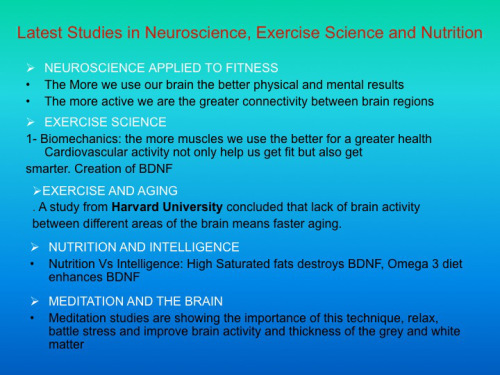Trends in health, aging, exercise science, neuroscience and meditation
Trends in brain decline, brain aging, exercise science, nutrition and meditation. Latest studies by Michael Gonzalez-Wallace
Cognitive abilities such as attention, memory, auditory processes, motor coordination or executive functions like planning or multitasking deteriorate over the time unless used regularly.
No matter what age group we belong to we should be aware of the latest trends in different fields. The most important fields in my opinion are Neuroscience applied to fitness, Exercise science, Nutrition, Exercise and Aging and Meditation.
-NEUROSCIENCE APPLIED TO FITNESS
-The More we use our brain the better physical and mental results
-The more active we are the greater connectivity between brain regions
-Complex motor learning combined with strength training is the best for the brain
-Neuroplasticity and Neurogenesis
-5 Tips to Prevent Cognitive decline
Enriched Environments. Exercise helps our brain work better but also create more synaptic connections. When our brains and bodies are in these enriched environments we are happier and in better shape than if we were in sedentary locations. Here is one of the most important studies showing the implications of exercise for brain health.
1.- Greenough, W. T., and A. M. Sirevaag. “Plasticity of GFAP-immunoreactive astrocyte size and number in visual cortex of rats reared in complex environments.” BrainResearch540, no. 1–2 (Feb. 1, 1991): 273–278.
2.-Krammer, Arthur F., et al. “Aerobic fitness is associated with hippocampal volume in elderly humans.” Hippocampus 19, no. 10 (Oct. 2009): 1030–1039.
Cardiovascular activity is connected with intelligence: exercise your beautiful heart. Can our heart makes us smarter? Charles Hillman Ph.D is a top scientist studying the connection of the heart on cognitive function. Here is groundbreaking study:
3.-Be smart, exercise your heart: exercise effects on brain and cognition. Hillman CH, Erickson KI, Kramer AF.
4.-Jen, C. J., and H.-I. Chen. “Differential effects of treadmill running and wheel running on spatial or aversive learning and memory: Roles of amygdalar brain-derived neurotrophic factor and synaptotagmin.” Journal of Physiology 587 (July 1, 2009): 3221–3231.
-EXERCISE SCIENCE
What is Biomechanics? Biomechanics is the science of movement of a living body, including how muscles, bones, tendons and ligaments work together to produce movement.
According to David Winter who is the Author of Biomechanics and Motor Control Biomechanics can be defined as an interdiscipline which describes, analyzes and asseses Human Movement. A wide variety of physical movements are involved -everything from the gait of the physically handicapped to the lifting of a load by a factory worker to the performance of a superior athlete. Click here for more information about Dr Winter
1- Biomechanics and whole body movements: the more muscles we use the better for a greater health/ Cardiovascular activity not only help us get fit but also get smarter.

Creative Total-Body Exercises by Rodney Corn, MA
Fitness Trends by the American College Sports of Medicine
. A study from Harvard University concluded that lack of brain activity between different areas of the brain means faster aging.
-NUTRITION AND INTELLIGENCE
•Nutrition Vs Intelligence: High Saturated fats destroys BDNF, Omega 3 diet enhances BDNF
MEDITATION AND THE BRAIN

According to the New York Times This exercise in focused awareness and mental catch-and-release of emotions has become perhaps the most popular new psychotherapy technique of the past decade.
•Meditation studies are showing the importance of this technique to battle relax, battle stress and improve brain activity and thickness of the grey and white matter
Practices like physical exercise, certain forms of psychological counseling and meditation can all change brains for the better, and these changes can be measured with the tools of modern neuroscience, according to a review article now online at Nature Neuroscience to keep reading click here
Social influences on neuroplasticity: stress and interventions to promote well-being
Experiential factors shape the neural circuits underlying social and emotional behavior from the prenatal period to the end of life. These factors include both incidental influences, such as early adversity, and intentional influences can be produced
Proc Natl Acad Sci U S A. 2012 Jun 11. [Epub ahead of print]
Mechanisms of white matter changes induced by meditation.Tang YY, Lu Q, Fan M, Yang Y, Posner MI.









Michael Gonzalez-Wallace's Blog




